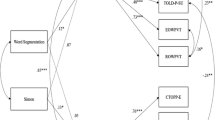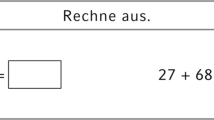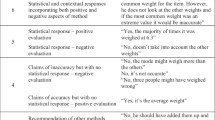Abstract
Competency measures in the area of statistical literacy have shown that learners’ achievement can be described by hierarchical models. However, empirical studies focusing on possible impact factors are scarce. In this paper we analyze students’ achievement concerning the competency using models and representations in statistical contexts, a core element of statistical literacy. We further investigate to which extent several learner variables such as reading comprehension and general cognitive abilities interdepend with this competency. Therefore, a corresponding competency measure and standardized psychometric tests for reading comprehension and general cognitive abilities were administered to 503 German 8th-graders. Additional information about grades in mathematics and the socio-economic status was taken into the analysis. The results indicate that students’ competency of using models and representations in statistical contexts is relatively homogeneous within our sample showing high solution rates concerning basic tasks and little success for the most challenging items. Multilevel regressions suggest that this competency is rather interdependent with general cognitive abilities, but less with reading comprehension. Implications are discussed with regard to the theoretical and practical level.
Zusammenfassung
Die Kompetenzmessung im Bereich von Statistical Literacy hat gezeigt, dass die Leistung von Lernenden mit hierarchischen Modellen beschrieben werden kann. Empirische Studien, die auf mögliche Einflussfaktoren abzielen, sind jedoch selten. In diesem Artikel untersuchen wir die Leistung von Schülerinnen und Schülern bezüglich der Kompetenz Nutzen von Darstellungen und Modellen in statistischen Kontexten, einem Kernelement von Statistical Literacy. Des Weiteren analysieren wir, inwieweit bestimmte Lernervariablen wie Leseverständnis und allgemeine kognitive Fähigkeiten mit dieser Kompetenz zusammenhängen. Zu diesem Zweck bearbeiteten 503 Achtklässler aus Deutschland einen entsprechenden Kompetenztest sowie standardisierte psychometrische Tests für Leseverständnis und allgemeine kognitive Fähigkeiten. Außerdem wurden Mathematiknote und sozio-ökonomischer Status in die Analyse einbezogen. Die Ergebnisse zeigen in unserer Stichprobe relativ homogene Ausprägungen der Kompetenz Nutzen von Darstellungen und Modellen in statistischen Kontexten mit hohen Lösungsraten für einfache Aufgaben und geringen Erfolgsquoten bei den schwierigsten Items. Mehrebenenregressionen legen es nahe, dass diese Kompetenz eher mit allgemeinen kognitiven Fähigkeiten als mit Leseverständnis zusammenhängt. Implikationen für Theorie und Praxis werden diskutiert.


Similar content being viewed by others
References
Batanero, C., Burril, G., & Reading, C. (2011). Teaching statistics in school mathematics – Challenges for teaching and teacher education. Dordrecht: Springer.
Ben-Zvi, D., & Garfield, J. (2004). Research on reasoning about variability. Statistics Education Research Journal, 3(2), 4–6.
Ben-Zvi, D., & Garfield, J. (2005). Statistical literacy, reasoning, and thinking: goals, definitions, and challenges. In D. Ben-Zvi J. Garfield (Eds.), The challenge of developing statistical literacy, reasoning, and thinking (pp. 3–15). Dordrecht: Springer.
Blum, W., & Leiss, D. (2005). Modellieren im Unterricht mit der „Tanken“-Aufgabe. mathematik lehren, 128, 18–21.
Bourdieu, P. (1986). The forms of capital. In J. Richardson (Ed.), Handbook of theory and research for the sociology of education (pp. 241–258). New York: Greenwood.
Bradley, R. H., & Corwyn, R. F. (2002). Socioeconomic status and child development. Annual Review of Psychology, 53, 371–399.
Brunner, M. (2005). Mathematische Schülerleistung: Struktur, Schulformunterschiede und Validität. Humboldt Universität zu Berlin. http://edoc.hu-berlin.de/dissertationen/brunner-martin-2006-02-08/PDF/brunner. Accessed 20 May 2014.
Carroll, J. B. (1993). Human cognitive abilities: a survey of factor-analytic studies. New York: Cambridge University Press.
Carroll, J. B. (1996). Mathematical abilities: some results from factor analysis. In R. J. Sternberg T. Ben-Zeev (Eds.), The nature of mathematical thinking (pp. 3–25). Mahwah: Lawrence Erlbaum.
Cattell, R. (1971). Abilities: their structure, growth, and action. New York: Houghton Mifflin.
Chalmers, R. P. (2012). Mirt: A multidimensional item response theory package for the R environment. Journal of Statistical Computing, 48(6). https://www.jstatsoft.org/article/view/v048i06. Accessed 29 Feb 2016.
Christmann, U. (2015). Lesen als Sinnkonstruktion. In U. Rautenberg U. Schneider (Eds.), Lesen. Ein Handbuch (pp. 169–184). Berlin: De Gruyter.
Curcio, F. R. (1987). Comprehension of mathematical relationships expressed in graphs. Journal for Research in Mathematics Education, 18(5), 382–393.
Eid, M., Gollwitzer, M., & Schmitt, M. (2011). Statistik und Forschungsmethoden. Weinheim: Beltz.
Enders, C. K., & Tofighi, D. (2007). Centering predictor variables in cross-sectional multilevel models: a new look at an old issue. Psychological Methods, 12(2), 121–138.
Gal, I. (2002). Adults’ statistical literacy: meanings, components, responsibilities. International Statistical Review, 70, 1–51.
Garfield, J., delMas, R., & Zieffler, A. (2012). Developing statistical modelers and thinkers in an introductory, tertiary-level statistics course. ZDM – The International Journal on Mathematics Education, 44(7), 883–898.
Greer, B. (1997). Modelling reality in mathematics classrooms: the case of word problems. Learning and instruction, 7(4), 293–307.
Heller, A. K., & Perleth, C. (2000). KFT 4–12+R. Manual. Göttingen: Beltz.
Holling, H., Preckel, F., & Vock, M. (2004). Intelligenzdiagnostik. Kompendien Psychologische Diagnostik (Band 6). Göttingen: Hogrefe.
Hox, J. (2010). Multilevel analysis. Techniques and applications. New York: Routledge.
IBM Corp (2010). IBM SPSS Statistics for Windows, Version 19.0. Armonk: IBM Corp.
Jäger, A. O. (1982). Mehrmodale Klassifikation von Intelligenzleistungen. Experimentell kontrollierte Weiterentwicklung eines deskriptiven Intelligenzstrukturmodells. Diagnostica, 28, 195–226.
Kamil, M., Mosenthal, P., Pearson, P., & Barr, R. (2000). Handbook of reading research, III. New York: Routledge.
Kintsch, W. (1998). Comprehension. A paradigm for cognition. New York: Cambridge University Press.
Klieme, E., Neubrand, M., & Lüdtke, O. (2001). Mathematische Grundbildung: Testkonzeption und Ergebnisse. In J. Baumert, E. Klieme, M. Neubrand, M. Prenzel, U. Schiefele, W. Schneider, P. Stanat, K. J. Tillmann M. Weiß (Eds.), PISA 2000. Basiskompetenzen von Schülerinnen und Schülern im internationalen Vergleich (pp. 141–191). Opladen: Leske + Budrich.
KMK (Kultusministerkonferenz) (2003). Bildungsstandards im Fach Mathematik für den mittleren Schulabschluss. München: Kluwer.
Kröpfl, B., Peschek, W., & Schneider, E. (2000). Stochastik in der Schule: Globale Ideen, lokale Bedeutungen, zentrale Tätigkeiten. mathematica didactica, 23, 25–57.
Kuntze, S. (2010). Zur Beschreibung von Kompetenzen des mathematischen Modellierens konkretisiert an inhaltlichen Leitideen – Eine Diskussion von Kompetenzmodellen als Grundlage für Förderkonzepte zum Modellieren im Mathematikunterricht. Der Mathematikunterricht (MU), 56(4), 4–19.
Kuntze, S. (2013). Modellieren beim Nutzen von Darstellungen in statistischen Kontexten. Hierarchische Beschreibung und Bedingungsvariablen eines Aspekts mathematischer Kompetenz. In R. Borromeo Ferri, G. Greefrath G. Kaiser (Eds.), Mathematisches Modellieren in Schule und Hochschule (pp. 71–94). Wiesbaden: Springer.
Kuntze, S., Lindmeier, A., & Reiss, K. (2008a). „Daten und Zufall“ als Leitidee für ein Kompetenzstufenmodell zum „Nutzen von Darstellungen und Modellen“ als Teilkomponente von Statistical Literacy. In A. Eichler J. Meyer (Eds.), Anregungen zum Stochastikunterricht (Vol. 4, pp. 111–122). Hildesheim: Franzbecker.
Kuntze, S., Lindmeier, A., & Reiss, K. (2008b). Using models and representations in statistical contexts” as a sub-competency of statistical literacy – Results from three empirical studies. Proceedings of the 11th International Congress on Mathematical Education. Monterrey (Mexico).
Kuntze, S., Engel, J., Martignon, L., & Gundlach, M. (2010). Aspects of statistical literacy between competency measures and indicators for conceptual knowledge – Empirical research in the project RIKO-STAT. In C. Reading (Ed.), Data and context in statistics education: towards an evidence-based society. Proceedings of the 8th International Conference on Teaching Statistics. Voorburg: International Statistical Institute.
Kuntze, S., Martignon, L., Vargas, F., & Engel, J. (2015). Competencies in understanding statistical information in primary and secondary school levels: an inter-cultural empirical study with German and Colombian students. AIEM – Avances de Investigación en Educación Matemática, 7, 5–25.
Land Baden-Wuerttemberg (2004). Bildungsstandards für Mathematik Realschule – Klassen 6, 8, 10. www.bildung-staerkt.menschen.de/service/downloads/Bildungsstandards/Rs/Rs_M_bs.pdf. Accessed 15 Nov 2011.
Leiss, D., Schukajlow, S., Blum, W., Messner, R., & Pekrun, R. (2010). The role of the situation model in mathematical modelling – task analyses, student competencies, and teacher interventions. Journal für Mathematik-Didaktik, 31(1), 119–141.
Lindmeier, A., Kuntze, S., & Reiss, K. (2007). Representations of data and manipulations trough reduction – competencies of German secondary students. In B. Philips L. Weldon (Eds.), Proceedings of the IASE/ISI Satellite Conference on Statistical Education, Guimarães (Portugal). Voorburg: International Statistical Institute. https://iase-web.org/documents/papers/sat2007/Lindmeier_et_al.pdf. Accessed 5.12.17.
Mayer, R. E., & Hegarty, M. (1996). The process of understanding mathematical problems. In R. J. Sternberg T. Ben-Zeev (Eds.), The nature of mathematical thinking (pp. 29–54). Mahwah: Lawrence Erlbaum.
Opdenakker, M. C., & Van Damme, J. (2001). Relationship between school composition and characteristics of school process and their effect on mathematics achievement. British Educational Research Journal, 27, 407–432.
Paulus, C. (2009). Die „Bücheraufgabe“ zur Bestimmung des kulturellen Kapitals bei Grundschülern. http://bildungswissenschaften.uni-saarland.de/personal/paulus/Artikel/BA_Artikel.pdf. Accessed 15 June 2013.
Raudenbush, S. W., Bryk, A. S., Cheong, A. S., Fai, Y. F., Congdon, R. T., & du Toit, M. (2011). HLM 7: Hierarchical linear and nonlinear modeling. Lincolnwood: Scientific Software International.
Reading, C. (2002). Profile for statistical understanding. In B. Philips (Ed.), Developing a statistically literate society. Proceedings of the 6th International Conference on Teaching Statistics, Cape Town. Voorburg: International Statistics Institute.
Schneider, W., Schlagmüller, M., & Ennemoser, M. (2007a). LGVT 6–12. Manual. Göttingen: Hogrefe.
Schneider, W., Schlagmüller, M., & Ennemoser, M. (2007b). LGVT 6–12. Testheft. Göttingen: Hogrefe.
Schnotz, W., & Dutke, S. (2004). Kognitionspsychologische Grundlagen der Lesekompetenz: Mehrebenenverarbeitung anhand multipler Informationsquellen. In U. Schiefele, C. Artelt, W. Schneider P. Stanat (Eds.), Struktur, Entwicklung und Förderung von Lesekompetenz (pp. 61–100). Wiesbaden: VS.
Sirin, S. R. (2005). Socioeconomic status and academic achievement: a meta-analytic review of research. Review of Educational Research, 75, 417–453.
Snijders, T., & Bosker, R. (1999). Multilevel analysis: an introduction to basic and advanced multilevel modeling. London: SAGE.
Sproesser, U., & Kuntze, S. (2013). Statistical thinking and language – a qualitative analysis. Proceedings of CERME 8, Antalya (Turkey). http://cerme8.metu.edu.tr/wgpapers/WG5/WG5_Sproesser.pdf. Accessed 3 Feb 2018.
Sproesser, U., Engel, J., & Kuntze, S. (2015). Abstieg oder Klassenerhalt? – Statistische Kennwerte rund um die Fußballbundesliga ermitteln. RAAbits Realschule Mathematik 27. Berlin: Raabe.
Sproesser, U., Engel, J., & Kuntze, S. (2016). Warten auf den nächsten Geysir-Ausbruch. mathematik lehren, 197(3), 15–19.
Sproesser, U., & Kuntze, S. (2018). Tasks for testing how students use models and representations in statistical contexts. https://doi.org/10.1007/s13138-018-0133-4. [Online supplement for this article].
Tent, L. (2001). Zensuren. In D. H. Rost (Ed.), Handwörterbuch Pädagogische Psychologie (pp. 805–811). Weinheim: Psychologie Verlags Union.
Vernon, P. E. (1964). The structure of human abilities. New York: Wiley.
Wallman, K. (1993). Enhancing statistical literacy: enriching our society. Journal of the American Statistical Association, 88(421), 1–8.
Watson, J. M., & Callingham, R. A. (2003). Statistical literacy: a complex hierarchical construct. Statistics Education Research Journal, 2, 3–46.
Wild, C. J., & Pfannkuch, M. (1999). Statistical thinking in empirical enquiry. International Statistical Review, 67, 223–265.
Willms, J. D. (1992). Monitoring school performance. London: Falmer.
Wu, M. L., Adams, R. J., Wilson, M. R., & Haldane, S. A. (2007). ACERconquest version 2: generalised item response modelling software. Camberwell: Australian Council for Educational Research.
Acknowledgements
This project was supported by research funds from Ludwigsburg University of Education. Ute Sproesser was a member of the Cooperative Research Training Group at the University of Tuebingen and the University of Education, Ludwigsburg, which was supported by the Ministry of Science, Research and the Arts in Baden-Wuerttemberg.
Author information
Authors and Affiliations
Corresponding author
Caption Electronic Supplementary Material
13138_2018_133_MOESM1_ESM.docx
The online supplement (Sproesser and Kuntze 2018) presents further details related to the MoReSC approach, describes hierarchical levels of competency for this aspect of statistical literacy, and discusses results on the item level.
Rights and permissions
About this article
Cite this article
Sproesser, U., Kuntze, S. & Engel, J. Using Models and Representations in Statistical Contexts. J Math Didakt 39, 343–367 (2018). https://doi.org/10.1007/s13138-018-0133-4
Received:
Accepted:
Published:
Issue Date:
DOI: https://doi.org/10.1007/s13138-018-0133-4




